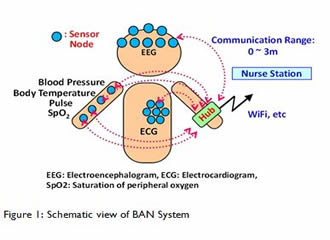Wireless transceiver technology for medical devices
Fujitsu Laboratories and imec Holst Centre have developed a wireless transceiver circuit for use in body area networks (BAN) for medical applications that adhere to the 400MHz-band international standard. Based on this joint research, Fujitsu plans to apply it to non-medical uses, such as to the monitoring of societal infrastructure, to further enhance network front-end interface technologies.
Medical applications, wireless monitoring of brainwaves or other vital signs has in the past required over a dozen mW of electric power. Now, however, by optimising the architecture and circuitry, Fujitsu and imec have succeeded in reducing the electric power requirements of wireless transceiver front-ends, to just 1.6mW when receiving data and 1.8mW when transmitting. This technology extends the battery life of conventional sensor products used for patient monitoring by approximately ten times. This reduces the frequency of battery replacement or recharges, lightens the burden on patients, and increases the work efficiency of medical practitioners.
In the field of healthcare and medicine, BAN have attracted attention for their potential application in collecting patient-monitoring data via a wireless network of sensors placed on the patient’s body. The various sensor nodes that make up the BAN all need battery power, and to make the system as convenient as possible for both the patient and medical practitioners, there is a need to extend battery run-times so the required frequency of battery replacement or recharging is held to a bare minimum.

The component in the sensor node that draws the most power is the wireless transceiver circuit, so to extend battery life, the power demands of that part need to be reduced. The challenge has been in developing a compact, low-power transceiver that can support the variations in transfer rates which medical systems require, without adding any new circuitry.







